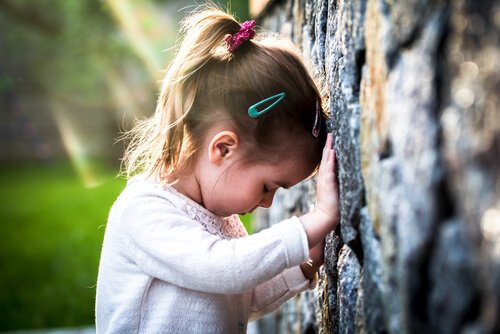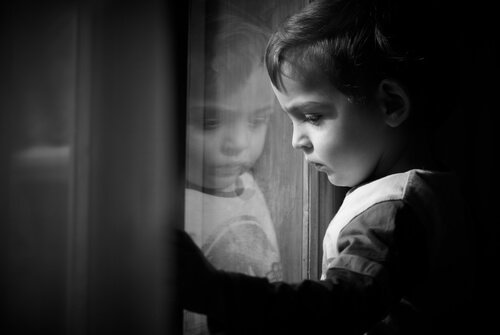Pathological Grief in Children

Grief is accepting and adapting to a loss (either of a loved one, an object, or a situation). It’s difficult for any individual. We, as adults, have probably experienced it at least once or twice and realized how difficult it is, let alone for children. Grief is especially difficult for kids since they’re more sensitive to changes and losses than the average adult.
That being said, pathological grief in children manifests as a maladaptive syndrome that can have serious consequences in their overall development and well-being. In this article, we analyze what pathological grief in children is, its prognosis, and its treatment.
“How lucky I am to have something that makes saying goodbye so hard.”
-Winnie the Pooh-
Pathological grief in children: What it is and its symptoms
We dare to say that most, if not all of us, have experienced the loss of a loved one. Even if you haven’t, it’s common knowledge that it’s deeply painful. When it comes to children, however, this reaction depends mainly on their maturational development. At the age of five or six, children begin to understand what death is. When they turn nine or ten, they’re able to understand it perfectly.
Basically, older children understand that death is an irreversible process, that the deceased person will never return and that they’ll have to readjust their world sooner or later.
Here are some of the characteristic symptoms of pathological grief in children:
- Intense sadness.
- Persistent crying.
- Irritability or aggressiveness.
- Thoughts about death.
- Denial and inability to accept or anger toward death.
- Intense melancholy and sorrow.
- Feeling of emptiness.
- Feeling of loneliness.
- Concern for the deceased.
- Anhedonia (state of stupefaction or long-lasting emotional shock).
- Difficulty communicating with others.
- Intense emotional reactions to the memory of the deceased.
- Psychosomatic disorders.
- Avoidance of places, people, or things related to the deceased and death itself.
As a result, these symptoms interfere with the child’s normal functioning, causing significant academic, social, and family issues.

Types of pathological grief in children and adults
Horowitz et al. (2003) identified four types of pathological grief in children and adults:
- Chronic grief: The pain of the loss is still intense after a year for adults and six months for children. The individual has a hard time adapting to their new life without their loved one.
- Postponed grief: After the loss, the person manifests only some emotions. However, after a while, they experience a strong emotional toll.
- Exaggerated grief: The person feels so overwhelmed by the pain that they may even resort to aggressive behavior and self-harm. In addition, this may lead to other psychological disorders.
- Masked grief: The person has physical and emotional issues that may lead to other problems. However, the person isn’t aware that such issues are derived from grief.
“Grief is like a long valley, a winding valley where any bend may reveal a totally new landscape.”
-C. S. Lewis-
Normal grief vs. pathological grief in children
A normal grieving process is understood as that vital stage in which a person:
- Reacts to the loss.
- Understands what the loss implies.
- Reorients their life without their loved one.
- Accepts the loss.
- The memory of the loved one doesn’t cause significant emotional reactions.
Now, how long should this process last? Scientists and mental health professionals agreed to establish an adjustment criterion rather than a temporal criterion. They also agreed that normal grief doesn’t hinder an individual’s life.
However, pathological grief in children, which lasts for at least 6 months, is a lot more complex. These are the main signs that characterize it:
- This grief is more intense and long-lasting.
- It gives rise to maladaptive, avoidance behavior that ultimately hinders or limits the child’s life.
- It can affect the child’s emotions, self-esteem, and identity.

The controversy linked to pathological grief in children
Some mental health professionals and scientists reject this diagnostic category in the DSM-5. The reason for this is that they believe each person processes, interprets, and expresses their emotions in their own particular way.
Therefore, for these psychologists, doctors, and psychiatrists, to include pathological grief as a psychopathological disorder would be nothing more than to believe an individual’s mentally ill when in reality they’re just sensitive to a loss.
On the other hand, other professionals actually agree on adding it to the DSM-5 just so that there’s more information about its particular signs and symptoms. They believe it’s important to understand its clinical picture, course, and prevalence in order to avoid misinformation and raise awareness on this topic and its effective treatment.
Some recommendations on pathological grief in children
Nowadays, there are effective psychological treatments to treat pathological grief in children and adults. The first thing that must be done is contact a psychologist to treat this condition.
However, we’d also like to share some other recommendations regarding pathological grief in children:
- Talk to the child and answer their questions and concerns.
- Allow the child to freely express their feelings and thoughts.
- Make sure that the child has appropriate information about death and that they know how their life will be like now that their loved one is gone.
- Also, be attentive enough to respond to any of their questions. Let them know that you’re there to help them with any fears or insecurities they may have.
- Be understanding and patient with the child.
- Offer them trust and affection throughout the entire process.
Whether it’s pathological or not, grief is never easy. It’s essential to learn to be there for people going through a loss. Instead of being judgmental, let them know that they’re not alone and that their feelings are completely valid. Be a helping hand in their process of adapting to a new reality.
“Grief is like the ocean; it comes on waves ebbing and flowing. Sometimes the water is calm, and sometimes it is overwhelming. All we can do is learn to swim.”
-Vicki Harrison-
Grief is accepting and adapting to a loss (either of a loved one, an object, or a situation). It’s difficult for any individual. We, as adults, have probably experienced it at least once or twice and realized how difficult it is, let alone for children. Grief is especially difficult for kids since they’re more sensitive to changes and losses than the average adult.
That being said, pathological grief in children manifests as a maladaptive syndrome that can have serious consequences in their overall development and well-being. In this article, we analyze what pathological grief in children is, its prognosis, and its treatment.
“How lucky I am to have something that makes saying goodbye so hard.”
-Winnie the Pooh-
Pathological grief in children: What it is and its symptoms
We dare to say that most, if not all of us, have experienced the loss of a loved one. Even if you haven’t, it’s common knowledge that it’s deeply painful. When it comes to children, however, this reaction depends mainly on their maturational development. At the age of five or six, children begin to understand what death is. When they turn nine or ten, they’re able to understand it perfectly.
Basically, older children understand that death is an irreversible process, that the deceased person will never return and that they’ll have to readjust their world sooner or later.
Here are some of the characteristic symptoms of pathological grief in children:
- Intense sadness.
- Persistent crying.
- Irritability or aggressiveness.
- Thoughts about death.
- Denial and inability to accept or anger toward death.
- Intense melancholy and sorrow.
- Feeling of emptiness.
- Feeling of loneliness.
- Concern for the deceased.
- Anhedonia (state of stupefaction or long-lasting emotional shock).
- Difficulty communicating with others.
- Intense emotional reactions to the memory of the deceased.
- Psychosomatic disorders.
- Avoidance of places, people, or things related to the deceased and death itself.
As a result, these symptoms interfere with the child’s normal functioning, causing significant academic, social, and family issues.

Types of pathological grief in children and adults
Horowitz et al. (2003) identified four types of pathological grief in children and adults:
- Chronic grief: The pain of the loss is still intense after a year for adults and six months for children. The individual has a hard time adapting to their new life without their loved one.
- Postponed grief: After the loss, the person manifests only some emotions. However, after a while, they experience a strong emotional toll.
- Exaggerated grief: The person feels so overwhelmed by the pain that they may even resort to aggressive behavior and self-harm. In addition, this may lead to other psychological disorders.
- Masked grief: The person has physical and emotional issues that may lead to other problems. However, the person isn’t aware that such issues are derived from grief.
“Grief is like a long valley, a winding valley where any bend may reveal a totally new landscape.”
-C. S. Lewis-
Normal grief vs. pathological grief in children
A normal grieving process is understood as that vital stage in which a person:
- Reacts to the loss.
- Understands what the loss implies.
- Reorients their life without their loved one.
- Accepts the loss.
- The memory of the loved one doesn’t cause significant emotional reactions.
Now, how long should this process last? Scientists and mental health professionals agreed to establish an adjustment criterion rather than a temporal criterion. They also agreed that normal grief doesn’t hinder an individual’s life.
However, pathological grief in children, which lasts for at least 6 months, is a lot more complex. These are the main signs that characterize it:
- This grief is more intense and long-lasting.
- It gives rise to maladaptive, avoidance behavior that ultimately hinders or limits the child’s life.
- It can affect the child’s emotions, self-esteem, and identity.

The controversy linked to pathological grief in children
Some mental health professionals and scientists reject this diagnostic category in the DSM-5. The reason for this is that they believe each person processes, interprets, and expresses their emotions in their own particular way.
Therefore, for these psychologists, doctors, and psychiatrists, to include pathological grief as a psychopathological disorder would be nothing more than to believe an individual’s mentally ill when in reality they’re just sensitive to a loss.
On the other hand, other professionals actually agree on adding it to the DSM-5 just so that there’s more information about its particular signs and symptoms. They believe it’s important to understand its clinical picture, course, and prevalence in order to avoid misinformation and raise awareness on this topic and its effective treatment.
Some recommendations on pathological grief in children
Nowadays, there are effective psychological treatments to treat pathological grief in children and adults. The first thing that must be done is contact a psychologist to treat this condition.
However, we’d also like to share some other recommendations regarding pathological grief in children:
- Talk to the child and answer their questions and concerns.
- Allow the child to freely express their feelings and thoughts.
- Make sure that the child has appropriate information about death and that they know how their life will be like now that their loved one is gone.
- Also, be attentive enough to respond to any of their questions. Let them know that you’re there to help them with any fears or insecurities they may have.
- Be understanding and patient with the child.
- Offer them trust and affection throughout the entire process.
Whether it’s pathological or not, grief is never easy. It’s essential to learn to be there for people going through a loss. Instead of being judgmental, let them know that they’re not alone and that their feelings are completely valid. Be a helping hand in their process of adapting to a new reality.
“Grief is like the ocean; it comes on waves ebbing and flowing. Sometimes the water is calm, and sometimes it is overwhelming. All we can do is learn to swim.”
-Vicki Harrison-
All cited sources were thoroughly reviewed by our team to ensure their quality, reliability, currency, and validity. The bibliography of this article was considered reliable and of academic or scientific accuracy.
- Barreto, P., & Soler, M. C. (2007). Muerte y duelo. Madrid: Síntesis.
- Díaz Curiel, J. (2011). Estudio de variables asociadas a la psicoterapia grupal en los procesos de duelo patológico. Revista de la Asociación Española de Neuropsiquiatría, 31(1), 93-107.
- Horowitz, M. J., Siegel, B., Holen, A., Bonanno, G. A., Milbrath, C., & Stinson, C. H. (2003). Diagnostic criteria for complicated grief disorder. Focus, 1(3), 290-298.
- Worden, J. W., Aparicio, Á., & Barberán, G. S. (1997). El tratamiento del duelo: asesoramiento
psicológico y terapia. Barcelona: Paidós.
This text is provided for informational purposes only and does not replace consultation with a professional. If in doubt, consult your specialist.







